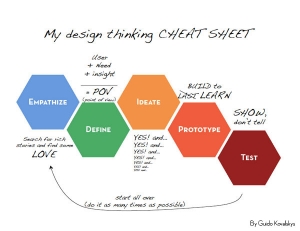We just wrapped up our fifth and final challenge project, and with the year quickly coming to a close I’ve been reflecting on the lessons learned throughout the past nine months. For our challenge projects, we are asked to use the human-centered design thinking process as a framework. There are five stages to the process as you’ll note in the image below.

The process begins with empathy, which includes engaging with those who will be impacted by the design solution. These interactions are not interviews, but rather conversations that help to provide insight. The second phase of the design thinking process uses the information gathered from the community to define the problem. Once the problem has been defined, an ideation session based on the design prompt and the empathy feedback is used to think of a range of possibilities to address the problem. After ideation, the top ideas from the session are prototyped and then tested by the community, wherein the process can begin again to streamline the solution.
Our challenge projects are just five short weeks, and we begin the process with a design prompt already created. The word “challenging” is apt for more reasons that one. Empathy is the most important and powerful piece of the process, but it can be difficult to make the connections needed within the community to provide the needed insights. It’s important to start this process early, to be flexible and to be persistent despite any failed attempts. Five weeks is also an incredibly short amount of time to craft a solution or recommendation.
The design thinking framework is an ideal tool to create a human-centered solution, but it’s important to recognize that design is not a linear process. Looping in and out of the phases is normal and necessary. Design is messy, it’s beautiful, it’s frustrating, it’s rewarding and ultimately hard to tell when you’ve reached a conclusion. As fellows, we’ve all been asked to step outside of our comfort zones, whether that is through learning new skills or through the “yes, and…” approach.
As we begin our final impact projects, I’m grateful for the lessons I have learned both from participating in these challenge projects and also from my fellow fellows.
